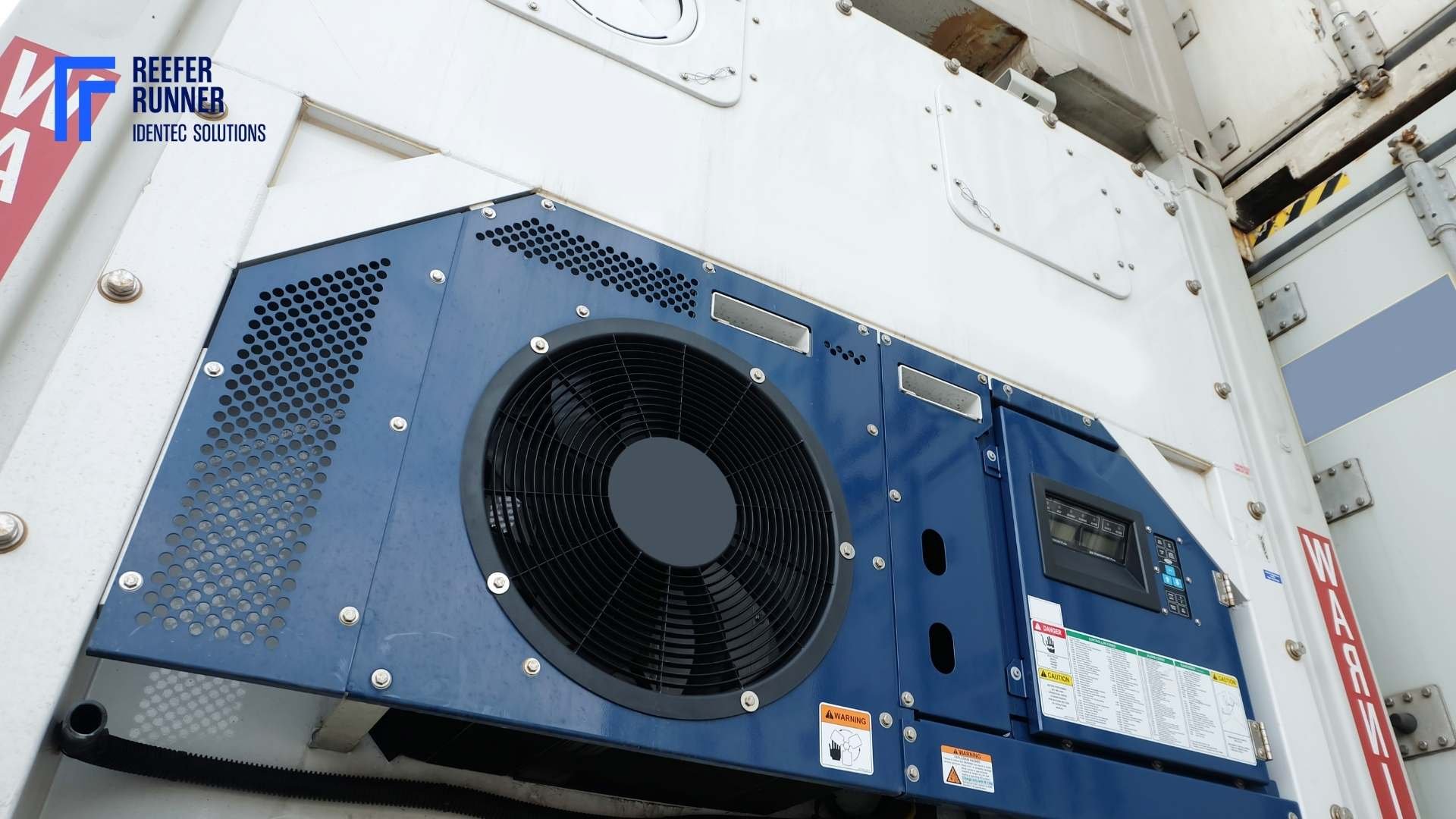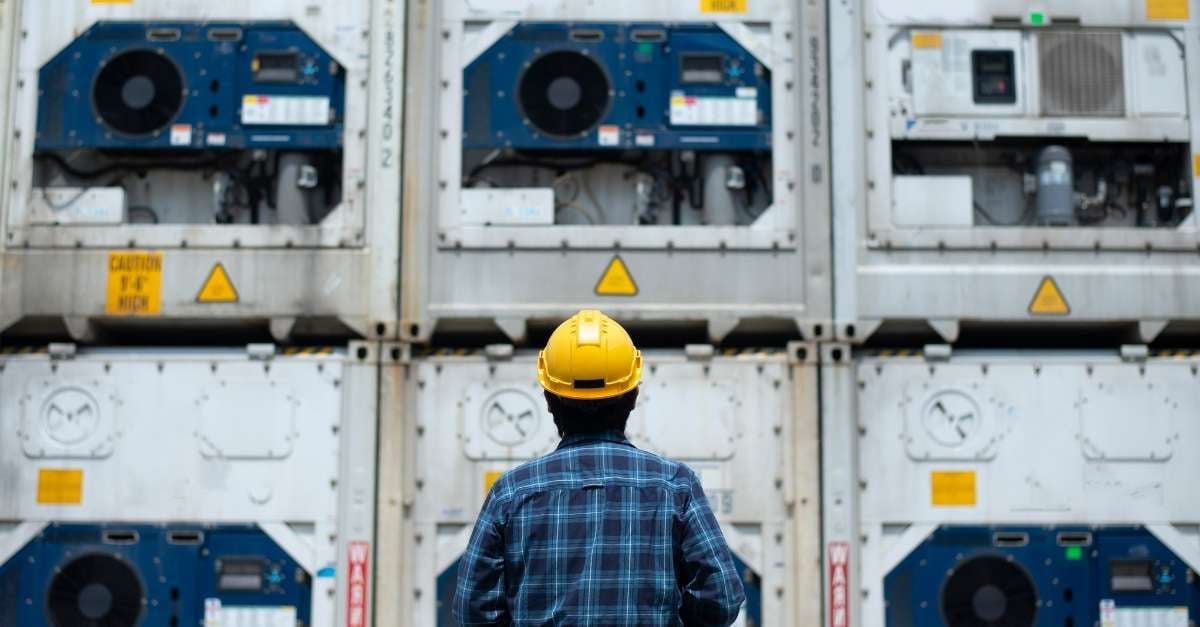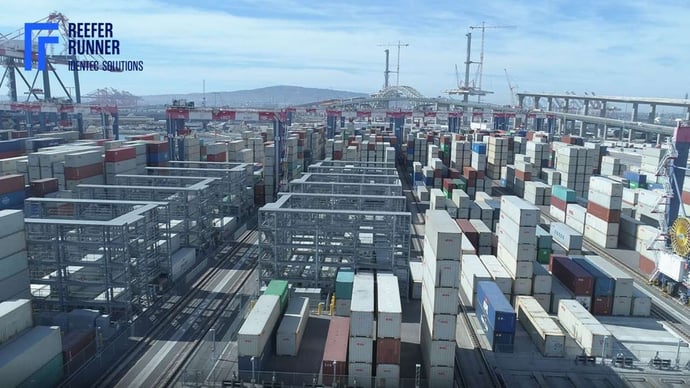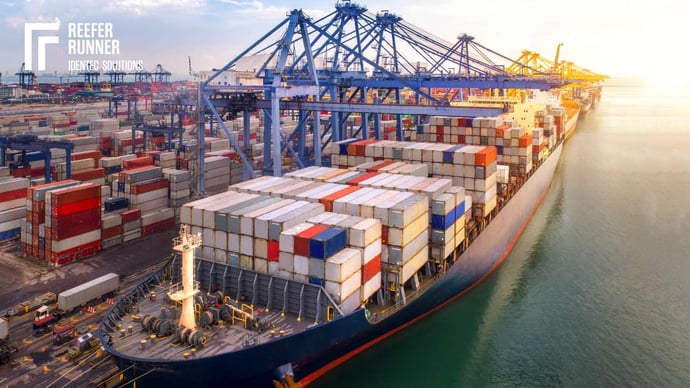Reefer operations: How to optimize efficiency and safety
| Written by Mark Buzinkay
As refrigerated containers are a vital part of the global supply chain, you don't want to break the cool chain at any point in the supply chain. However, reefer cargo is temperature-sensitive and spoiling it comes with high costs.
Reefer operations in a container terminal are labour-intensive and need constant monitoring and management. An automated reefer monitoring and management solution gives you total control of your terminal reefer operations.

No video selected
Select a video type in the sidebar.
"Integrating automated systems in reefer management enhances not just operational workflows but also safety, protecting both workers and the valuable cargo they handle."
Jordi Asensio, Product Manager Reefer Runner
Using refrigerated containers (reefer) is a vital part of the global supply chain that connects producers and consumers worldwide. The most important rule is: Don't break the cool chain at any point of the supply chain. Otherwise, the cargo gets spoiled or altered and won't be usable for sale.
A refrigerated container
- is a shipping container used in intermodal freight transportation to move temperature-sensitive cargo,
- can control temperature and atmosphere,
- relies on external power, and
- is handled by an internal controller.
TYPICAL REEFER OPERATIONS
Refrigerated containers are bottom air delivery units designed to distribute chilled air from the floor, via specific T-shaped decking, with the advantage of producing a consistent and uniform flow of air across the entire shipment, powerful enough to ensure a perfect air exchange with the goods.
Reefer operatives must follow specific procedures for preparing, stuffing, removing cargo, and reloading into alternate reefer containers. Once a reefer container is loaded, the doors closed properly, and the correct set points for temperature, humidity and air ventilation entered, the reefer unit can be started.
The power for supplying a reefer comes from a genset. A genset, short for generator set, is a power unit that provides the container with electricity. A reefer container does not cool itself; therefore, a generator set is necessary to provide it with electricity worldwide. Electricity is supplied from sources such as power plugs, the gas tank of a truck or other sources.
Without supplying power to the reefer, the cargo inside can become damaged or completely ruined. Therefore, it is expected that the reefer container's insulation system can maintain internal cargo area temperatures within 1-2 degrees Celsius of the cargo protocol temperature, even with average power disconnection time periods of 1 to 6 hours during its trip.
Depending on the manufacturer's guidelines for the container refrigeration unit, its technical condition and the required temperature level in the box, the average power consumption in a 40′ container ranges from 6 to 9 kW.
Without being supplied with power, a reefer shipping container acts as a cool box. They are designed to maintain the container's temperature, humidity and atmosphere at a constant value during the whole transit time. Therefore, when shipping reefer cargo, four settings must be considered (and constantly monitored): temperature, ventilation, humidity and drainage.

REEFER OPERATIONS SAFETY
During transport and temporary storage (e.g. waiting for loading on a vessel), the abovementioned settings must be monitored and secured to avoid breaking the cool chain. In addition, the supply of power to the genset is critical. Therefore, three basic activities are executed when transported on trucks, trains, vessels or in planes and during temporary storage: plugging, unplugging and monitoring.
460V typically powers reefer containers. A reefer unit requires a three-phase electrical system with a supply voltage of 440/460-volt, whereas some units are also available with three-phase 208/230-volt transformers. Because of the high voltage, safety is a high priority during reefer handling, especially when plugging and unplugging the unit.
Before plugging the reefer, the power source must be off. Then, the reefer cord can be pulled out. First, reefer operatives must inspect it for damage (e.g. exposed wires, cuts), and if detected, they must be reported. Never plug in a damaged power cord! Next, the operative should also check the condition of the power plug itself. If the power plug is cracked or crushed, are there any burn marks, or the pins are not in good condition, don't use the power plug. Eventually, connect the power cord with the power receptacle and secure the safety ring. Now the reefer operative can turn the power on. When the reefer operative looks at the reefer display, it should appear (learn more about reefer container power supply here).
The display of all manufacturers will show the actual temperature inside the reefer unit, power supply, and a menu to operate the display, settings and any alarms. Typically, the temperature zone should be set, but if this is missing, it must be entered to adjust the unit temperature to the recommended temperature range for the transported cargo. Not all cargo needs a deep freeze.
One of the main tasks of a reefer operative (e.g. in a container terminal, but also the truck driver) is to monitor, document, and even sometimes correct on request the settings and temperature inside the reefer unit. As each unit has a recommended temperature range, the reefer operative must compare it with the data shown on the reefer display. If they deviate, she must act. Either way, data shown at the display must be recorded with a time log for documentation and potential damage claims from the cargo owner. Data includes not only temperature but also humidity, power supply, and also alarms.
Manual reefer monitoring in a container terminal can be tedious as there are sometimes hundreds and thousands of refrigerated containers stacked up to 3-4 containers high. Monitoring means inspecting every reefer individually, checking for alarms and documenting the displayed values. Every shift, a field operative must check for warnings and write down the monitoring data for the record of all reefers in the yard.
As reefer operatives walk literally from refrigerated containers to the next, another safety aspect becomes omnipresent: terminal vehicles such as cranes, RTGs and other machinery are constantly moving and represent a potentially fatal hazard in the yard. For safety reasons, automated operations (e.g., cranes) must stop before personnel can enter the area (a dedicated reefer block) and continue their inspection. In addition, idle machines reduce the overall terminal efficiency, resulting in higher costs per movement.
Before a reefer is picked up by container handling equipment (CHE) for relocation within the yard, onto a truck or loading on a vessel, it must be disconnected from power. To unplug a reefer correctly, the reefer operative must first turn off the power source before touching the power cord or the plug. Then she can unlock the safety ring from the power plug and remove the power cord from the receptacle. Finally, the power cord is coiled into the cord housing in front of the reefer unit. With the power cord secured, the unit is clear to be moved.
Unplugging a refrigerated container has to be done with good timing. Unplugging a container too early can end the reefer without a power source for too long and endanger the cargo inside the unit. On the other hand, if it is unplugged late, it may delay loading a vessel and even leaving an entire container ship. In the worst case, unplugging is forgotten, and a container handling equipment removes the reefer unit too early, causing a rupture of the power cable, damage to the genset and risk of further damages or even accidents due to hanging cables.
The final task of moving reefer containers out of the container terminal is to hand out a record of the monitoring data to the shipping line. They must be kept for potential claims.
AUTOMATED REEFER OPERATIONS IMPROVING SAFETY
As we have seen, reefer operations are tedious, labour-intensive, potentially harmful and subject to claims if not handled correctly. One answer to improving the reefer logistics process is to automate it, except for the steps of plugging and unplugging reefers from power:
-
Improves speed and quality of processes: Information is available at any time 24/7 for every single reefer.
-
Increases visibility in the field: The conditions (power supply, temperature, alarms) are visible to the Reefer operative independently of his current position.
-
Protection & prevention against claims: Automated reefer solutions record temperature and other factors and serve as safe documentation in case of claims. It is easy to produce digital records anytime and on any reefer.
-
Prevents human error: Temperature is set up by the system following the shipping document. Therefore, there is no space for human error.
-
Energy monitoring: First, the energy supply is monitored. Second, the energy usage is calculated and can become automatically part of the invoice.
-
Peak shaving: As energy peaks are costly and reefers can be without power for a specific time before dropping temperature, yard consumption peaks can be avoided when shutting down reefers selectively.
-
Improves safety: As the system reduces the amount of manual work in the yard, potential risks for the workforce decrease accordingly. Personnel can focus on remote work or on other aspects of reefer operations (e.g. plug/unplug).
Further reading: Puerto Bolivar and automated reefer operation
Concluding, automated solutions manage the reefer logistics process: Automated monitoring, alarm management and escalation, digital reefer record and energy consumption monitoring.
Usually, automated checking includes also:
-
Possible error conditions
-
Setpoints (TOS vs controller)
-
Container ID vs manifest
-
Setpoint vs temperatures
-
State transitions (Illegal state transitions - move before disconnection)
-
Work order completion
-
Alarm resolution
-
Unplanned / accidental disconnects
-
Reefer power loss
-
System status & interface health
-
All problems detected result in alarms

FAQ
What essential topics should be included in safety training for reefer monitoring?
Safety training for reefer monitoring must inform personnel of all hazards posed by reefers and train them in their safe and effective use. This requires understanding the technical aspects of reefer operation, including the correct procedures for manual inspections and interventions.
Therefore, the instructions include emergency protocols such as recognising and responding to refrigerant leaks, electrical faults and overheating. It is also recommended that the correct use of personal protective equipment (PPE) be emphasised.
Alarms are another critical topic. These include alerts displayed on the reefers themselves as well as those shown in the automatic monitoring systems. In the case of the former, care must be taken to ensure that the specific characteristics of each manufacturer are taken into account in the courses.
Simulations of real-life scenarios help to reinforce safe practices. Previous incidents can be used as illustrative examples, in particular if they are well documented. This allows real-life problems to be played out in a known environment, including the measures taken.
Regular refresher courses and drills ensure safety practices remain current and evolve with new technologies or updated protocols. Keeping crews up to date with technical training and a focus on raising risk awareness contributes to a safe and efficient work environment.
TAKEAWAY
As refrigerated containers are a vital part of the global supply chain, you don't want to break the cool chain at any point in the supply chain. However, Reefer cargo is temperature-sensitive and spoiling it comes with high costs. Managing and monitoring reefers in container terminals is a short stage of the entire supply chain but critical. Reefer operations in a container terminal are labour-intensive and need constant monitoring and management. An automated reefer monitoring and management solution gives you total control of your terminal reefer operations.
Dive deeper into one of our core topics: Refrigerated containers

Author
Mark Buzinkay, Head of Marketing
Mark Buzinkay holds a PhD in Virtual Anthropology, a Master in Business Administration (Telecommunications Mgmt), a Master of Science in Information Management and a Master of Arts in History, Sociology and Philosophy. Mark spent most of his professional career developing and creating business ideas - from a marketing, organisational and process point of view. He is fascinated by the digital transformation of industries, especially manufacturing and logistics. Mark writes mainly about Industry 4.0, maritime logistics, process and change management, innovations onshore and offshore, and the digital transformation in general.
Related Articles

Reefer Alarm: Safeguarding Cold Chain Precision

No Disruption: How automated reefer monitoring impacts safety and productivity simultaneously

Automated refrigerated Reefer monitoring results in fewer claims

Reefer productivity: Why automate your operations?

Reefer Power Consumption: How Long Can You Afford Not To Know?
Related Product

